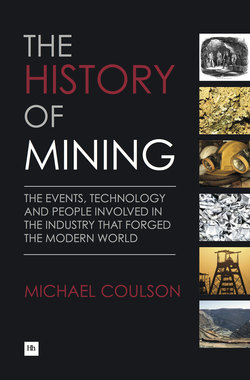Читать книгу The History of Mining - Michael Coulson - Страница 37
На сайте Литреса книга снята с продажи.
5. Great Britain
ОглавлениеUntil the 20th century Great Britain was a major producer of metals. Initially, in the Middle Ages, it was an exporter, but it turned consumer as the Industrial Revolution broke and then finally it became a major importer in its role as the world’s leading industrial power. In the Middle Ages England was on the edge of Europe, a feisty independent country with an historical relationship with France going back to the Norman Conquest, in the aftermath of which Britain inherited power over huge swathes of France which it gradually lost.
In due course continental powers like Spain, Holland and France came into conflict with England, which due to its powerful navy was becoming increasingly outward looking, a match militarily for anyone wanting to make trouble, and confident enough to start expanding its global reach through land acquisition and eventually colonisation. This latter development was a key part of the economic imperative to find natural resources to fuel the Industrial Revolution.
The importance of silver in the Middle Ages in its role as specie or coin led to a surge in silver mining, as we have observed earlier. England as an historic source of the metal became a serious producer based on the revival of its past operations in the southwest and new mines developed further north. Following the Norman Conquest in 1066 England’s silver mining industry was to be found in Somerset’s Mendip Hills, the Derbyshire Peak District, on the Welsh borders and in the North Pennines, which was the location of the most productive mines.
The ownership structure, which had been based for centuries on who owned the land where the silver was found, changed during the 13th century when the Crown claimed control of the silver, and therefore of the mines being developed in Devon at the end of that century. In this still feudal era there were also surprising examples of self-employed miners who leased mines, which they worked for personal returns. In the earlier part of the Middle Ages the mines were in the main small hand dug pits, but as we have seen elsewhere the veins often plunged and so shafts had to be sunk to follow the mineralisation. These shafts were sunk to the level of the water table where the miners had to de-water by hand. In due course rising silver prices on the continent financed the development of mechanised de-watering systems in the late 15th century, often using wheel and bucket lifting methods. There was also an environmental cost to the re-opening of the silver mines of south Devon, namely the stripping of woodland for fuel to be used in the treatment process and to provide mine timbers.
Silver and lead mining continued off and on in Devon well into the 18th century, as did mining in the North Pennines, and new mines were also established in mid-Wales. By the end of the 18th century mining had begun to extend below the water table in Devon as technological advances led to the development of steam-powered pumps capable of greatly exceeding the pumping rate of traditional bucket de-watering methods.
As far as treatment processes were concerned, new smelting techniques gave rise to changing fuel types, from traditional charcoal, on to peat where available, and then later in the 19th century coal, helped by advances in smelting technology, became the prime fuel. This also led to the development of treatment complexes close to the expanding coalfields.
